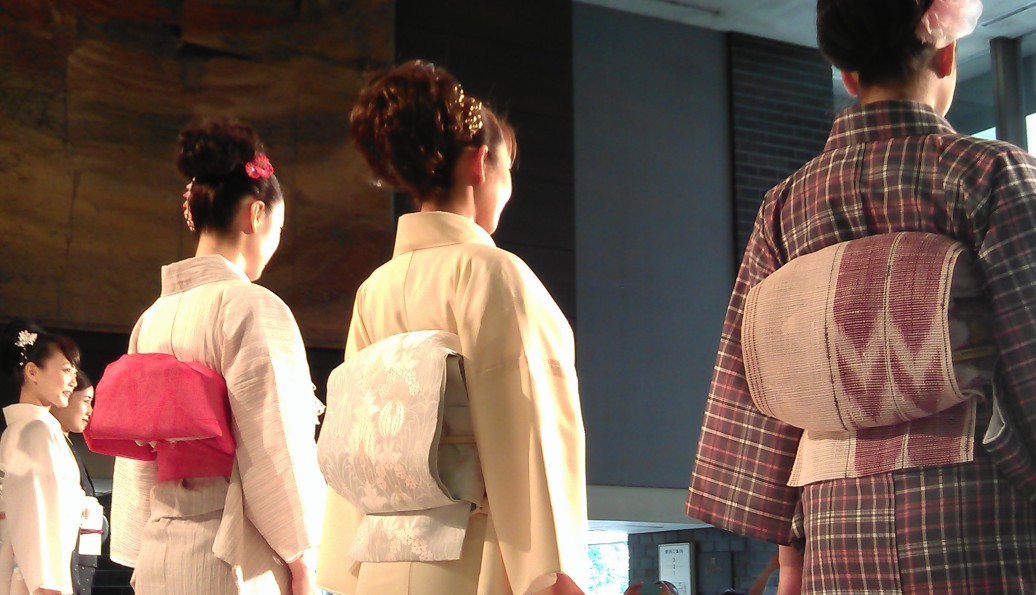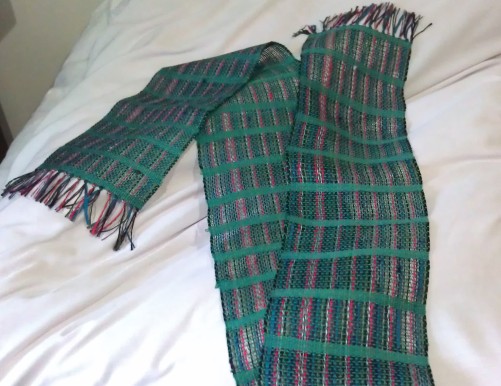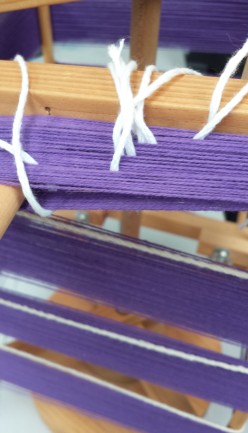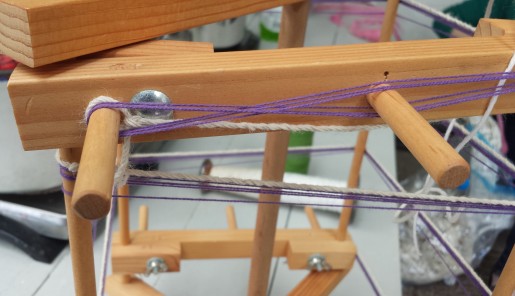There is nothing quite like getting stuck into a new thing. You haven’t quite yet realised how impossibly hard it will be to reproduce all the maddeningly complex projects you’ve been eyeing up on Pinterest and you’re new enough that you’re pleased by any new creation, no matter how wonky the stitches or sad the seams are.
It was back in Kyoto, at the Nishijin Textile Centre, that I first had a go at weaving. Nishijin is the legendary textiles district that gives its name to Nishijin-ori, the fabric produced there. It is known for its quality and the incredibly intricate patterns and designs in the weave that are often used for highly elaborate obis. In more modern times, nishijin-ori is often used in neckties or gamaguchi, the metal clasp purses that are very popular in Japan.

At the Nishijin Textile Centre, you can see a collection of the textiles produced there and the weaving equipment used. They have a nice collection of silk worms and there is also the opportunity to see some amazing artisans at work.
They offer ‘craft experiences’ where you can have a go at using the looms yourself, under the guidance of one of their expert weavers. I’m not sure whether they are available in English but if you’re feeling brave you can probably fumble your way through. It was lovely to spend a few hours on one of the floor looms, listening to the rather satisfying ‘donk’ they make and hearing about my teacher’s experiences working in commercial weaving and about the textile industry in Japan.

However, whilst I really enjoyed the process, I was slightly less than impressed with what I made. Not quite as unimpressed as my grandmother was when I presented her with said item as a thoughtful ‘gift’ though.
It’s Japanese silk but either it’s in good need of a wash or it’s the most horrible, scratchy silk on the planet. The ‘scarf’ also had all the drape of a steel bar so was repurposed as a table runner, to inhabit the back of the cupboard and never be seen again. The one small mercy is I like the colour and the fringing is alright.
When you are all warped up, the shuttles are wound and the colours picked, weaving isn’t the most complicated thing in the world, at least when it is a plain weave. It definitely takes practice to get the tension and positioning of threads even but it did feel a little bit mindless. Plus, where’s the fun in only knowing half the process?
I’ve been dithering on learning to weave properly for a while, mostly out of fear of the associated equipment costs, but when an embroidery course I was supposed to be attending was cancelled, it seemed like the perfect opportunity to try. It was off to Leewood for a few days with the wonderful Jane Deane for me!

Leewood is in Dartmoor National Park in Devon, not too far from Yelverton. It’s a lovely farm that offers some glamping, for those who prefer camping with hospitable showers and toilets, as well as various craft courses in the company of some rather petulant chickens and sheep. There is also a continual supply of delicious cake.

It’s near enough civilisation to be a quick drive from Plymouth but far enough that phone signal is somewhat sparse. Perfect for a proper, picturesque escape for a few days. I came here at some point last year for a spinning and dyeing course with Jane, which is where she got me absolutely hooked on all things silk and colour. In her defence, I probably didn’t need much encouragement there but after a few days teaching, I was happily spinning even, fine yarns and splashing dye about with probably too much confidence.


I’ve been really fortunate to have some absolutely amazing teachers over the years and still find there is no substitute for going to a class. What I love about Jane’s teaching is that she really focuses on getting you to understand the technique, rather than just follow a series of instructions, so it’s much easier to do your own learning and creative work. She also has such a wealth of knowledge and creative ideas that I always leave having had a thoroughly enjoyable time and enough projects to keep me busy into the next lifetime.

Weaving is one of those things that there is a huge amount of prep work before you end up with even a millimetre of fabric. I’d opted to learn on an 8 shaft table loom, as opposed to a rigid heddle, as I wanted more flexibility with the designs and patterns I could weave. That meant there was rather a lot of work to do before I could even get near the loom!

The first stage of weaving is making up the warp, something that seems a bit bizarre the first time you do it. I had access to a warping mill, which made the whole process of winding and winding much easier and even quite therapeutic. I do recommend having some handy ‘stitch marker’ style devices to hand to save having to re-count how much you’ve wrapped.

As well as being the first step in the process, this is also where the first mistake happened. It appears that the sacred rule of warp-making is never ever lose the cross that you form. It is opening yourself to a world of pain, frustration and knots if you do…
I saw some amazing weaving at West Dean College near Chichester when I was there recently. I even came away with some lovely yarns ‘from the cutting room floor’ they were about to be thrown in the bin!
LikeLiked by 1 person
Excellent find! I’ll have to investigate if I’m ever over that way.
LikeLiked by 1 person
[…] Day 1 of learning to weave hadn’t scared me off, so I was keen to get stuck into understanding more about the contraption that is the weaving loom. […]
LikeLike
I just watched the bbc mastercraft program on weaving (on YouTube), which made me very glad I only bought a rigid heddle loom. It will be a while before I weave fine silk, but never say never
LikeLiked by 1 person
I wish silk was a bit cheaper so I could exclusively weave with it… Yeah, it’s quite an involved process getting started but I like the flexibility of the shaft looms although you can do some incredible work on rigid heddles and they are definitely a lot quicker!
LikeLiked by 1 person
I’m still eyeing my warping board with distrust. One day….
LikeLiked by 1 person
Go for it! They’re quite hard work though, I do wish I had a mill instead.
LikeLike
What a wonderful post on your weaving experiences! The very first craft I fell in love with was weaving so I totally feel your pain – EVERYTHING iis excruciatingly expensive.
Thank goodness for people who for one reason or another give up their looms. If anyone really wants to weave on a floor loom it’s worth waiting for a good used loom to come along. As long as no-one stores them in basements or garages, there is no reason that they can’t go on forever.
My beloved loom, Penelope, is a 45″ 4 shaft LeClerc jack loom. She is 50 years old , is beautiful, and works a treat. I found her, a perfect bench, 2 reeds, bobbin and yarn winders, and even a few stick shuttles for good measure! I paid $750.00 Canadian dollars for her. (about $600.00 US at the time)
She is the best damned housemate anyone could ever have. So compared to crochet, knitting and embroidery, weaving is a bit pricey but it doesn’t have to break the bank either. 🙂
BTW, I envy you your trips and classes, they look amazing!
I am loving your blog,
Baba StringThings
LikeLiked by 1 person
My weaving teacher has a saying about how the right loom or wheel will find out, definitely sounds like yours did. She does sound like a wonderful housemate, bet she never leaves the bin overflowing either!
I was really lucky to find a second hand 8 shaft table loom and have a huge debt of gratitude to the weaver who sold it to me (and sent me away with some of her gorgeous hand-dyed yarns!)
Thanks for the compliments and I hope you enjoy my future stories as much as I do.
LikeLiked by 1 person
I am sure I will enjoy your future posts as your past ones are wonderful.
And btw, 8 shafts and hand-dyed yarns?
SCORE! 🙂
LikeLiked by 1 person
[…] done a weaving experience at the Nishijin Textile Factory where I made a scarf/table-runner hybrid with all the charm and textural properties of a bag of […]
LikeLike